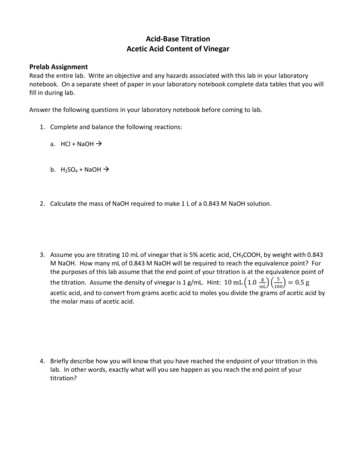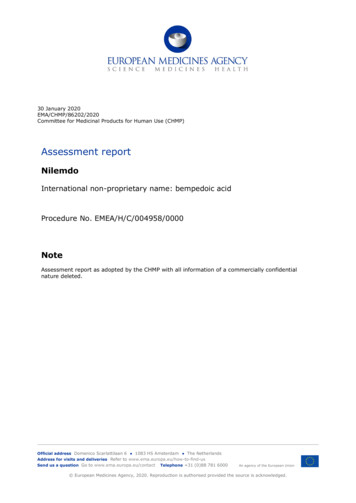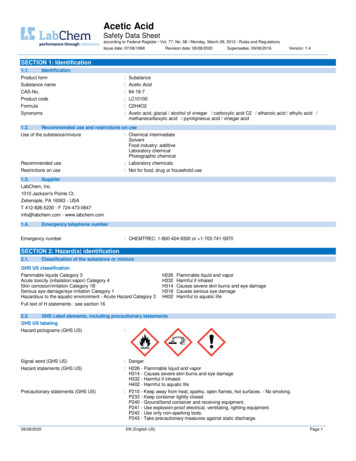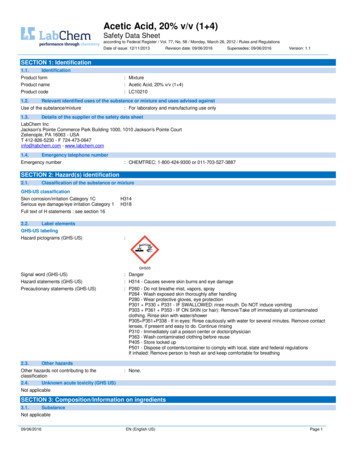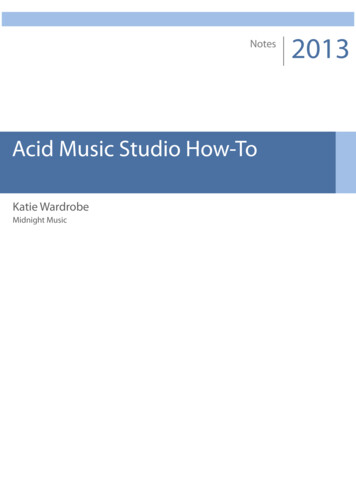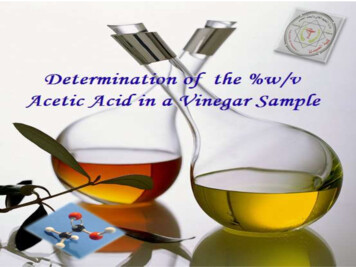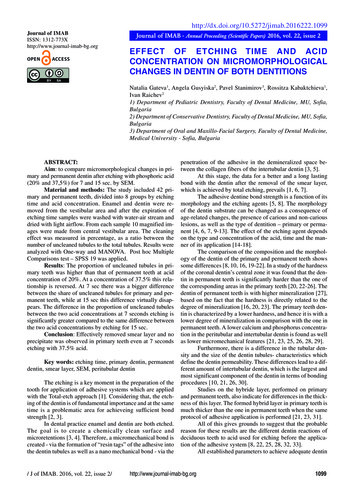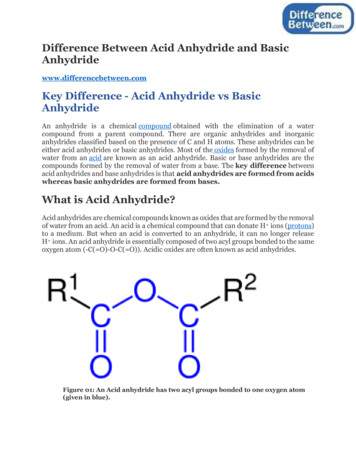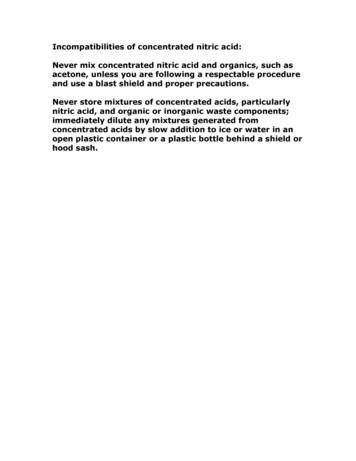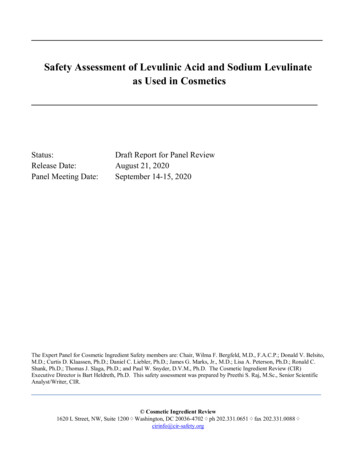
Transcription
Safety Assessment of Levulinic Acid and Sodium Levulinateas Used in CosmeticsStatus:Release Date:Panel Meeting Date:Draft Report for Panel ReviewAugust 21, 2020September 14-15, 2020The Expert Panel for Cosmetic Ingredient Safety members are: Chair, Wilma F. Bergfeld, M.D., F.A.C.P.; Donald V. Belsito,M.D.; Curtis D. Klaassen, Ph.D.; Daniel C. Liebler, Ph.D.; James G. Marks, Jr., M.D.; Lisa A. Peterson, Ph.D.; Ronald C.Shank, Ph.D.; Thomas J. Slaga, Ph.D.; and Paul W. Snyder, D.V.M., Ph.D. The Cosmetic Ingredient Review (CIR)Executive Director is Bart Heldreth, Ph.D. This safety assessment was prepared by Preethi S. Raj, M.Sc., Senior ScientificAnalyst/Writer, CIR. Cosmetic Ingredient Review1620 L Street, NW, Suite 1200 Washington, DC 20036-4702 ph 202.331.0651 fax 202.331.0088 cirinfo@cir-safety.org
Distributed for Comment Only -- Do Not Cite or QuoteCommitment & Credibility since 1976MemorandumTo:Expert Panel for Cosmetic Ingredient Safety Members and LiaisonsFrom:Preethi S. Raj, M.Sc.Senior Scientific Analyst, CIRDate:August 21, 2020Subject:Safety Assessment of Levulinic Acid and Sodium Levulinate as Used in CosmeticsEnclosed is the draft report of the Safety Assessment of Levulinic Acid and Sodium Levulinate as Used in Cosmetics(identified as levaci092020rep in the pdf). This is the first time the Panel is seeing a safety assessment of these cosmeticingredients. A Scientific Literature Review (SLR) was announced on February 21, 2020. Following the announcement ofthe SLR, two human repeat insult patch tests for Sodium Levulinate were received, and have been included in this report(levaci092020data2): Essex Testing Clinic, Inc. (2016) Clinical safety evaluation repeated insult patch test of a product containing0.4011% Sodium LevulinateEssex Testing Clinic, Inc. (2016) Clinical safety evaluation repeated insult patch test of a product containing0.57% Sodium LevulinateComments on the SLR (levaci092020pcpc) that were received from the Council have been addressed. Also included in thispackage, for your review, are a flow chart (levaci092020flow), literature search strategy (levaci092020strat), ingredientdata profile (levaci092020prof), ingredient history (levaci092020hist), 2020 FDA VCRP data (levaci092020FDA), and2019 concentration of use data (levaci092020data1).After reviewing these documents, if the available data are deemed sufficient to make a determination of safety, the Panelshould issue a Tentative Report with a safe as used, safe with qualifications, or unsafe conclusion, and Discussion itemsshould be identified. If the available data are insufficient, the Panel should issue an Insufficient Data Announcement(IDA), specifying the data needs therein.1620 L Street, NW Suite 1200, Washington, DC 20036(Main) 202-331-0651 (Fax) 202-331-0088(email) cirinfo@cir-safety.org (website) www.cir-safety.org
Distributed for Comment Only -- Do Not Cite or QuoteSAFETY ASSESSMENT FLOW CHARTINGREDIENT/FAMILY Levulinic Acid & Sodium LevulinateMEETINGSeptember 2020Public CommentCIRExpert PanelPriority ListINGREDIENTReport StatusPRIORITY LISTSLRFebruary 21, 202060-day public comment periodDRAFT REPORTSept 2020Draft ReportTableTableIDAIDA NoticeDraft TRTRIDADRAFT TENTATIVEREPORTTableTableIssue TRTentative ReportDraft FRDRAFT FINAL REPORT60-day Public comment periodTableTablePUBLISHFinal ReportDifferent ConclusionIssueFR
Distributed for Comment Only -- Do Not Cite or QuoteCIR History of:Levulinic Acid and Sodium LevulinateJanuary 2019-Concentration of use data submitted by CouncilJanuary 2020-FDA frequency of use data obtainedFebruary 2020-Levulinic Acid and Sodium Levulinate SLR posted on the CIR websiteData received: March 2, 2020: Two HRIPTs for 0.4011% and 0.57% Sodium LevulinateSeptember 2020-A Draft Report is being presented to the Panel.
Distributed for Comment Only -- Do Not Cite or Quote* “X” indicates that data were available in a category for the ingredient1XXCase malXIn ermalSensitizationIn VitroDermalIrritationHumanOralCarciDermalIn VitroXIn halationADMEXRepeatedDose ToxIn VitroXOralXXDermalXDermalPenetrationXXlog P/log KowXXImpuritiesMethod of MfgLevulinic AcidSodium LevulinateReported UseToxicokinetics Acute ToxDermalLevulinic Acid and Sodium Levulinate Data Profile* – September 14-15th, 2020 – Writer, Preethi Raj
Distributed for Comment Only -- Do Not Cite or Quote[Levulinic Acid and Sodium Levulinate]IngredientCAS #123-76-2Levulinic Acid;4-oxovaleric acid19856-23-6SodiumLevulinate;Sodium ONIOSHFEMAWeb PubMed TOXNET * * * NRNRNR * * NR NRNR * *NRNR NRNRNRNRNRNRNRNRNRNRNRNR – not reported or available - data is available *- in database, but data is not available or relevanttotal # useful/total # of hitsSearch Strategy[document search strategy used for SciFinder, PubMed, and Toxnet - total # useful/ total number of hits ]Sodium Levulinate – 2/6Levulinic Acid – 3/926"123-76-2" AND toxicity – 1/7"19856-23-6" - 4/346(((levulinic acid) OR "123-76-2") AND oral toxicity) - 0/1(((levulinic acid) OR "123-76-2") AND chemical structure) – 3/432(((levulinic acid) OR "123-76-2") AND manufacturing) – 0/4(((levulinic acid) OR "123-76-2") AND impurities) – 1/6((((levulinic acid) OR "123-76-2") AND toxicokinetics)) - 3/25((((levulinic acid) OR "123-76-2") AND dermal penetration)) - 0/0((((levulinic acid) OR "123-76-2") AND inhalation)) -0/2((((levulinic acid) OR "123-76-2") AND acute toxicity)) – 0/2((((levulinic acid) OR "123-76-2") AND short term toxicity)) - 0/0((((levulinic acid) OR "123-76-2") AND subchronic toxicity)) – 0/0((((levulinic acid) OR "123-76-2") AND chronic toxicity)) – 0/2((((levulinic acid) OR "123-76-2") AND developmental toxicity)) – 0/2((((levulinic acid) OR "123-76-2") AND reproductive toxicity)) – 0/1((((levulinic acid) OR "123-76-2") AND cancer)) -0/87((((levulinic acid) OR "123-76-2") AND mutagenicity)) – 1/1((((levulinic acid) OR "123-76-2") AND genotoxicity)) – 0/0((((levulinic acid) OR "123-76-2") AND cytotoxicity)) – 0/8((((levulinic acid) OR "123-76-2") AND dermal irritation)) – 0/0((((levulinic acid) OR "123-76-2") AND dermal sensitization)) – 0/0((((levulinic acid) OR "123-76-2") AND phototoxicity)) – 1/2((((levulinic acid) OR "123-76-2") AND ocular irritation)) – 0/0((((levulinic acid) OR "123-76-2") AND mucous membrane irritation)) – 0/0((((levulinic acid) OR "123-76-2") AND case reports)) -0/22HPVIS NICNAS NTIS
Distributed for Comment Only -- Do Not Cite or Quote((((levulinic acid) OR "123-76-2") AND adverse events)) – 1/1((((levulinic acid) OR "123-76-2") AND epidemiology)) – 0/4General SearchLevulinic acid cosmetic useSodium Levulinate cosmetic useTypical Search Terms INCI names CAS numbers chemical/technical names:o Levulinic Acid: 3-Acetylpropionic Acid – 0/2,952,706 4-Ketovaleric Acid-0/2 4-Oxopentanoic Acid [AND toxicity] – 0/6 4-Oxovaleric Acid -1/2 Pentanoic Acid, 4-Oxo-2/30o Sodium Levulinate: Pentanoic Acid, 4-oxo-, Sodium Salt – 0/0 additional terms will be used as appropriateLINKSSearch Engines Pubmed (- http://www.ncbi.nlm.nih.gov/pubmed) Toxnet (https://toxnet.nlm.nih.gov/); (includes Toxline; HSDB; ChemIDPlus; DART; IRIS; CCRIS; CPDB; GENE-TOX)appropriate qualifiers are used as necessarysearch results are reviewed to identify relevant documentsPertinent Websites wINCI - http://webdictionary.personalcarecouncil.org FDA databases http://www.ecfr.gov/cgi-bin/ECFR?page browseFDA search databases: y/ucm234631.htm;,EAFUS: ation.cfm?rpt eafuslisting&displayall trueGRAS listing: ng/gras/default.htmSCOGS database: ng/gras/scogs/ucm2006852.htmIndirect Food Additives: http://www.accessdata.fda.gov/scripts/fdcc/?set IndirectAdditivesDrug Approvals and Database: t.htm
Distributed for Comment Only -- Do Not Cite or Quote es/CDER/UCM135688.pdfFDA Orange Book: 9662.htmOTC ingredient list: 88.pdf(inactive ingredients approved for drugs: http://www.accessdata.fda.gov/scripts/cder/iig/ HPVIS (EPA High-Production Volume Info Systems) - https://ofmext.epa.gov/hpvis/HPVISlogonNIOSH (National Institute for Occupational Safety and Health) - http://www.cdc.gov/niosh/NTIS (National Technical Information Service) - http://www.ntis.gov/NTP (National Toxicology Program ) - http://ntp.niehs.nih.gov/Office of Dietary Supplements https://ods.od.nih.gov/FEMA (Flavor & Extract Manufacturers Association) - http://www.femaflavor.org/search/apachesolr search/ EU CosIng database: ECHA (European Chemicals Agency – REACH dossiers) – ssionid A978100B4E4CC39C78C93A851EB3E3C7.live1ECETOC (European Centre for Ecotoxicology and Toxicology of Chemicals) - http://www.ecetoc.orgEuropean Medicines Agency (EMA) - http://www.ema.europa.eu/ema/IUCLID (International Uniform Chemical Information Database) - https://iuclid6.echa.europa.eu/searchOECD SIDS (Organisation for Economic Co-operation and Development Screening Info Data Sets)- http://webnet.oecd.org/hpv/ui/Search.aspxSCCS (Scientific Committee for Consumer Safety) opinions: http://ec.europa.eu/health/scientific committees/consumer safety/opinions/index en.htmNICNAS (Australian National Industrial Chemical Notification and Assessment Scheme)- https://www.nicnas.gov.au/ International Programme on Chemical Safety http://www.inchem.org/FAO (Food and Agriculture Organization of the United Nations) - ific-advice/jecfa/jecfa-additives/en/WHO (World Health Organization) technical reports - http://www.who.int/biologicals/technical report series/en/ www.google.com - a general Google search should be performed for additional background information, to identify references that are available, and for other generalinformationBotanical Websites, if applicable Dr. Duke’s - https://phytochem.nal.usda.gov/phytochem/search Taxonomy database - http://www.ncbi.nlm.nih.gov/taxonomy GRIN (U.S. National Plant Germplasm System) - nomysimple.aspx Sigma Aldrich plant profiler- -research/learning-center/plant-profiler.html American Herbal Products Association Botanical Safety Handbook (database) - ook.aspx European Medicines Agency Herbal Medicines - http://www.ema.europa.eu/ema/index.jsp?curl pages/medicines/landing/herbal search.jsp National Agricultural Library NAL Catalog (AGRICOLA) https://agricola.nal.usda.gov/ The Seasoning and Spice Association List of Culinary Herbs and Spices http://www.seasoningandspice.org.uk/ssa/background culinary-herbs-spices.aspxFragrance Websites, if applicable IFRA (International Fragrance Association) – http://www.ifraorg.org/ Research Institute for Fragrance Materials (RIFM)
Distributed for Comment Only -- Do Not Cite or QuoteSafety Assessment of Levulinic Acid and Sodium Levulinateas Used in CosmeticsStatus:Release Date:Panel Meeting Date:Draft Report for Panel ReviewAugust 21, 2020September 14-15, 2020The Expert Panel for Cosmetic Ingredient Safety members are: Chair, Wilma F. Bergfeld, M.D., F.A.C.P.; Donald V. Belsito,M.D.; Curtis D. Klaassen, Ph.D.; Daniel C. Liebler, Ph.D.; James G. Marks, Jr., M.D.; Lisa A. Peterson, Ph.D.; Ronald C.Shank, Ph.D.; Thomas J. Slaga, Ph.D.; and Paul W. Snyder, D.V.M., Ph.D. The Cosmetic Ingredient Review (CIR)Executive Director is Bart Heldreth, Ph.D. This safety assessment was prepared by Preethi S. Raj, M.Sc., Senior ScientificAnalyst/Writer, CIR. Cosmetic Ingredient Review1620 L Street, NW, Suite 1200 Washington, DC 20036-4702 ph 202.331.0651 fax 202.331.0088 cirinfo@cir-safety.org
Distributed for Comment Only -- Do Not Cite or QuoteINTRODUCTIONThis is a safety assessment of Levulinic Acid and Sodium Levulinate, as used in cosmetic formulations. According tothe web-based International Cosmetic Ingredient Dictionary and Handbook (wINCI; Dictionary), Levulinic Acid andSodium Levulinate both are reported to function in cosmetics as skin conditioning agents; Levulinic Acid is also reported tofunction as a fragrance ingredient.1The ingredients reviewed in this safety assessment may be consumed in food, and daily exposure from food use wouldresult in much larger systemic exposures than those possible from use in cosmetic products. Therefore, the primary focus ofthe safety assessment of these ingredients as used in cosmetics is on the potential for local effects (e.g., from topicalexposure).Sodium Levulinate is the salt of Levulinic Acid. Upon dissociation in aqueous solution, these ingredients are identical.Thus, these ingredients are reviewed together in this report.This safety assessment includes relevant published and unpublished data that are available for each endpoint that isevaluated. Published data are identified by conducting an exhaustive search of the world’s literature. A listing of the searchengines and websites that are used and the sources that are typically explored, as well as the endpoints that the Expert Panelfor Cosmetic Ingredient Safety (Panel) typically evaluates, is provided on the Cosmetic Ingredient Review (CIR) /preliminary-search-engines-and-websites; rt-format-outline). Unpublished data are provided by the cosmetics industry, as well asby other interested parties.Much of the data included in this safety assessment was found on the European Chemicals Agency (ECHA) website.2,3Please note that the ECHA website provides summaries of information generated by industry, and it is those summary datathat are reported in this safety assessment when ECHA is cited. Data from a Research Institute for Fragrance Materials(RIFM) safety assessment pre-proof of Levulinic Acid have also been included, and that assessment is cited when primaryreferences were not available.4CHEMISTRYDefinition and StructureLevulinic Acid (CAS No. 123-76-2) is the organic acid that conforms to the structure depicted in Figure 1.1 LevulinicAcid is a 5-carbon, oxocarboxylic, keto acid.5Figure 1. Levulinic AcidSodium Levulinate (CAS No. 19856-23-6) is the sodium salt of Levulinic Acid1 that conforms to the structure depictedin Figure 2.Figure 2. Sodium LevulinateChemical PropertiesLevulinic Acid and Sodium Levulinate are both highly soluble in water and comprise carboxylic acid and ketonefunctional groups.2,3,6,7 While Sodium Levulinate is a solid, sodium salt, Levulinic Acid is a solid with a low melting point,which exhibits limited granularity.2Ultraviolet-visible (UV/Vis) absorption spectra were obtained for Levulinic Acid.4 No significant absorption wasobserved between 290 and 700 nm, and the corresponding molar absorption coefficient was well below the 1000 l/mol cmthreshold for phototoxic effects. The chemical properties of Levulinic Acid and Sodium Levulinate are further outlined inTable 1.
Distributed for Comment Only -- Do Not Cite or QuoteNatural OccurrenceLevulinic Acid is found in both natural and processed foods, such as Chinese quince, papaya, rice, sake, and wheatenbread.8Method of ManufactureThe following are general industrial methods of manufacture; it is unknown if these apply to the manufacture ofcosmetic ingredients. Levulinic Acid can be produced from low grade cellulose,9 sugar and starchy crops, wood, organicwaste, or algae, as a hydrolyzation and conversion step in the biorefinery process.10 Sugars and starches are the mostfrequently used feedstock for mass production of Levulinic Acid and typically undergo a multi-step manufacturing process,including hydrolysis of poylsaccharides with a Brønsted-Lowry acid (such as sulfuric acid) to yield hexose or pentose sugars(such as glucose), isomerization of glucose by a Lewis acid to yield fructose, dehydration of fructose to5-(hydroxylmethyl)furfural (5-HMF) by a bifunctional acid,5,9 and, lastly, rehydration of 5-HMF by a Brønsted-Lowry acidto yield Levulinic Acid.10 Sodium salts, such as Sodium Levulinate, are typically derived from the reaction of the free acid(e.g., Levulinic Acid) with an inorganic base, such as sodium hydroxide.1ImpuritiesThe acceptance criteria for food-grade Levulinic Acid is no lower than 97% purity.11 No further impurities data werefound in the published literature, and unpublished data were not submitted.USECosmeticThe safety of the cosmetic ingredients addressed in this assessment is evaluated based on data received from the USFood and Drug Administration (FDA) and the cosmetics industry on the expected use of these ingredient in cosmetics. Usefrequencies of individual ingredients in cosmetics are collected from manufacturers and reported by cosmetic productcategory in the FDA Voluntary Cosmetic Registration Program (VCRP) database. Use concentration data are submitted bythe cosmetic industry in response to surveys, conducted by the Personal Care Products Council (Council), of maximumreported use concentrations by product category.According to 2020 VCRP survey data, Levulinic Acid is reported to be used in 131 cosmetic formulations, and SodiumLevulinate is reported to be used in 402 cosmetic formulations, 293 of which are leave-on products (Table 2).12 Results fromthe 2019 concentration of use survey, conducted by the Council, indicate that Levulinic Acid has the highest maximumconcentration of use, at 4.5% in hair dyes, while Sodium Levulinate is used at a maximum concentration of 0.62% inmouthwashes and breath fresheners.13 The greatest concentrations for leave-on dermal exposure are in foundationscontaining Levulinic Acid (0.0005%) and eye shadows containing Sodium Levulinate (0.57%).Additionally, these ingredients have been reported to be used in products that may come into contact with the eyes; forexample, Sodium Levulinate is reported to be used at up to 0.57% in eye shadows. The use of both ingredients in mouthfreshening products, at a reported maximum concentration of 0.35% for Levulinic Acid and 0.62% for Sodium Levulinate,may lead to incidental ingestion and exposure to mucous membranes; frequency of use data were not reported in the VCRPfor either ingredient for this use. Levulinic Acid and Sodium Levulinate have reported uses in baby products, and SodiumLevulinate is reported to be used at up to a 0.35% in baby lotion, oil, or cream formulations. Sodium Levulinate is reportedto be used in face powder formulations (concentration of use not reported), and, could therefore possibly be inhaled.Conservative estimates of inhalation exposures to respirable particles during the use of loose powder cosmetic products are400-fold to 1000-fold less than protective regulatory and guidance limits for inert airborne respirable particles in theworkplace.14-16Both Levulinic Acid and Sodium Levulinate are not restricted from use in any way under the rules governing cosmeticproducts in the European Union.17Non-CosmeticThe bulk of Levulinic Acid use is as a chemical intermediate in the manufacture of biofuels and chemicals, fuelextenders, biodegradable polymers, plasticizers, herbicides, and antibiotics.5,18In the US, Levulinic Acid is a food additive approved for human consumption as a flavoring agent and relatedsubstance, assuming good manufacturing practices and minimum use to achieve the desired effect. [2
Aug 21, 2020 · *- in database, but data is not available or relevant . total # useful/total # of hits . Search Strategy [document search strategy used for SciFinder, PubMed, and Toxnet - total # useful/ total number of hits ] Sodium Levulinate – 2/6 . Levulinic Ac
